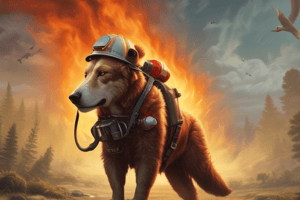Podcast
Questions and Answers
What are some of the logistical issues faced by wildlife rehabilitation facilities?
What are some of the logistical issues faced by wildlife rehabilitation facilities?
Wildlife rehabilitation facilities face issues like ensuring the animals receive the correct food sources and minimizing stress due to captivity.
How does effective wildlife rescue have a positive impact on species recovery and conservation efforts?
How does effective wildlife rescue have a positive impact on species recovery and conservation efforts?
Effective wildlife rescue ensures endangered species can recover from injuries and illnesses, increasing their chances of survival, and it can serve as a platform to study wildlife behavior and identify potential threats.
What is the importance of preparing animals for release through controlled environments like wildlife sanctuaries?
What is the importance of preparing animals for release through controlled environments like wildlife sanctuaries?
Preparing animals for release through controlled environments like wildlife sanctuaries is vital to improving their chances of survival and reproduction.
How has social media played a role in supporting wildlife rescue initiatives?
How has social media played a role in supporting wildlife rescue initiatives?
What are some future improvements and collaborations needed to advance wildlife rescue?
What are some future improvements and collaborations needed to advance wildlife rescue?
Study Notes
Wildlife Rescue: A Critical Component of Species Recovery and Conservation
Introduction
Wildlife rescue refers to the act of saving and preserving endangered or injured wildlife by providing medical attention, nourishment, and protection until they can return to their natural habitats. It plays a critical role in maintaining the balance of ecosystems, protecting vulnerable species, and educating the public about the importance of wildlife conservation. This article explores various aspects of wildlife rescue, highlighting the challenges faced, the impact on species recovery and conservation efforts, and the potential for future improvements in wildlife management strategies.
Challenges in Wildlife Rescue
The practice of wildlife rescue presents several challenges that must be addressed to ensure the safety and well-being of the animals involved. One challenge is the need for specialized knowledge and resources to handle and treat different species. Each species requires unique care and rehabilitation techniques, making it essential to maintain an expert team capable of dealing with a wide range of injuries and conditions.
Another significant hurdle is the risk of releasing animals back into their natural environment without proper preparation. Underprepared releases can lead to the failure of acclimatization, which increases the likelihood of death for the released animals. Therefore, preparing animals for release through controlled environments, such as wildlife sanctuaries, is vital to improving their chances of survival and reproduction.
Unfortunately, funding constraints often limit the capacity and reach of wildlife rescue organizations, making it difficult to save all endangered creatures. Furthermore, wildlife rehabilitation facilities face numerous logistical issues, such as ensuring that the animals receive the correct food sources during their stay and minimizing stress due to captivity.
Impact on Species Recovery and Conservation Efforts
Effective wildlife rescue has a positive impact on species recovery and conservation. By providing medical attention and rehabilitation, it ensures that endangered species can recover from injuries and illnesses, increasing their chances of survival. Moreover, rescue programs can serve as platforms to study wildlife behavior and identify potential threats.
One example of the successful implementation of wildlife rescue is the work done by the Alabama Wildlife Center, which cares for various species of bird and mammals, including orphans and injured animals. Another notable initiative is the collaboration between researchers, wildlife rehabilitators, and veterinarians, who work together to enhance the effectiveness of rescue programs.
Social Media and Public Engagement
Social media has played a substantial role in raising awareness about wildlife rescue initiatives, engaging local and global communities, and generating financial support for conservation efforts. Platforms like Facebook and Instagram have allowed people to follow the progress of individual animals, fostering emotional connections and inspiring donations.
The use of ambassadors, or animals that have been successfully rescued and rehabilitated, can further boost public engagement and promote wildlife conservation efforts. Such animals can participate in educational campaigns, helping to raise awareness about the plight of endangered species and the importance of conservation.
Future Improvements and Further Collaboration
To advance wildlife rescue, it is essential to establish formalized guidelines and training programs for volunteers, which can help standardize practices and increase efficiency. This includes leveraging technology, such as GPS tracking devices, to monitor the progress of rescued animals and improve their chances of success.
Collaboration between various stakeholders, including scientists, rehabilitators, veterinarians, and conservation organizations, is crucial for optimizing wildlife rescue programs. Joint efforts can lead to better data collection and analysis, improved animal care practices, and more effective conservation strategies.
Conclusion
Wildlife rescue plays a vital role in supporting endangered species, maintaining ecosystems, and educating the public about the importance of conservation efforts. Despite numerous challenges, ongoing improvements in techniques, collaboration, and technology offer hope for the continued success of these initiatives. By working together and recognizing the potential value of wildlife rescue as a critical component of species recovery and conservation, we can help protect our planet's most vulnerable creatures.
Studying That Suits You
Use AI to generate personalized quizzes and flashcards to suit your learning preferences.
Description
Test your knowledge on wildlife rescue, species recovery, and conservation efforts with this quiz. Explore the challenges faced in wildlife rescue, the impact on species recovery, and the importance of public engagement. Learn about future improvements and collaborations needed to enhance wildlife rescue practices.




